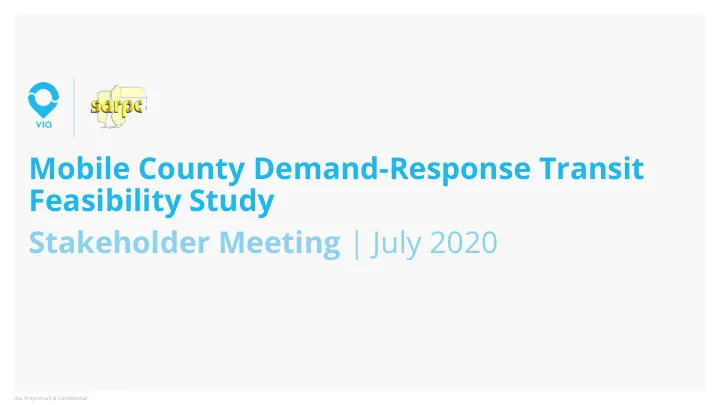

1 Mobile County Demand-Response Transit Feasibility Study Stakeholder Meeting | July 2020 Via. Proprietary & Confidential
Study Goals and Objectives 2 Context: ● Wave Transit service has a limited service area. ● 94% of all trips rely on private vehicles. ● No agency in Mobile County has been designated to receive FTA Section 5311 Rural Areas funding, which would likely be available if a provider were designated. Study Goals: ● Does Mobile County require a rural transit service ? ● Who would use the service? ● If so, what type of service would be most suitable? ● How should the service be funded ?
Task 1: Transit Needs Assessment 3 Subtasks: ● Engaged ~40 stakeholders ● Reviewed existing transit options ● Reviewed socio-economic data Conclusions: ● Most of the trips in Mobile County are not accessible using Wave Transit ● Seniors, low-income individuals, youth, and job seekers are likely to use a rural transit service ● Access to healthcare is a critical use-case ● Some transportation services exist but they are focused on specific needs - e.g., healthcare trips for certain individual.
Task 2: Transit Service Analysis 4 Conclusions: ● A countywide rural and urban service is desirable: ○ Don’t allow trips that can be completed using Wave Transit ○ Demand may outstrip vehicle capacity as the service grows ● A demand-response service will be most efficient and user-friendly (short walks, moderate wait times) ● Smaller vehicles (e.g. six-seater vans) would be appropriate given the low density of ridership ● Based on peer counties, Mobile County may have demand for 200 - 500 trips per day
Task 3: Transit Service Cost 5 Conclusions: ● Service can be scaled depending on funding available ● Estimated cost is $1.0 - $2.0M per year. ● A larger budget would mean more vehicles , delivering shorter wait times and more trips. ● As the service grows, vehicles can gradually be added to the fleet (can scale with demand). ● The main costs are driver wages and vehicle purchase or leasing.
Task 4: Transit Funding Sources 6 Conclusions: ● Section 5311 - Rural and Small Area Grant is designed for exactly this purpose ○ No agency in Mobile County has applied for this funding ○ Typically covers more than half of total service cost ● Fares, advertising, and other funding sources can reduce the funding gap further ● Approximately $300-$500k in local funding will be required ○ Typically provided by county commission and other local government agencies ○ Supplemented by non-profits and other agencies who may be interested in outsourcing their transportation needs ○ Conversations with employers and other private sector organizations have not identified many promising funding sources .
Next Steps 7 1. Build community support. 2. Secure funding. 3. Launch the service.
Questions for this group? 8 1. Do you have feedback on the report?
from here ? Questions for this group? 9 2. What can you do to help ensure that the idea progresses
Recommend
More recommend